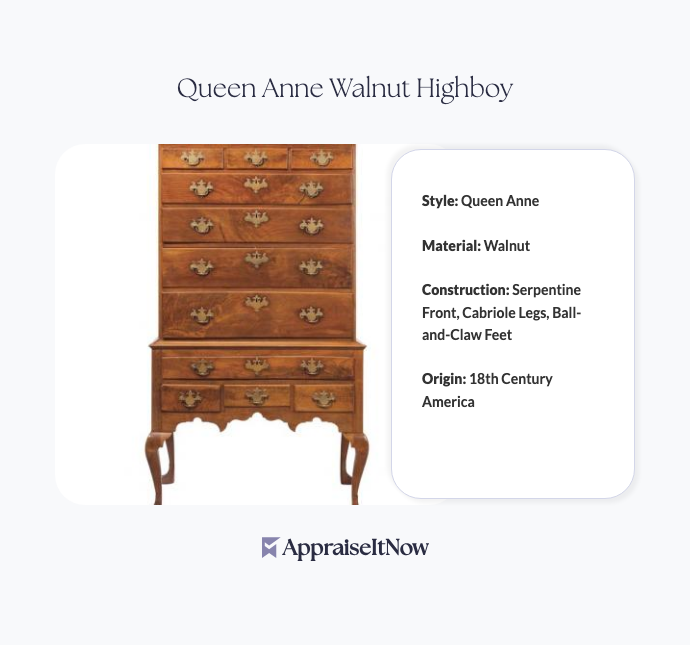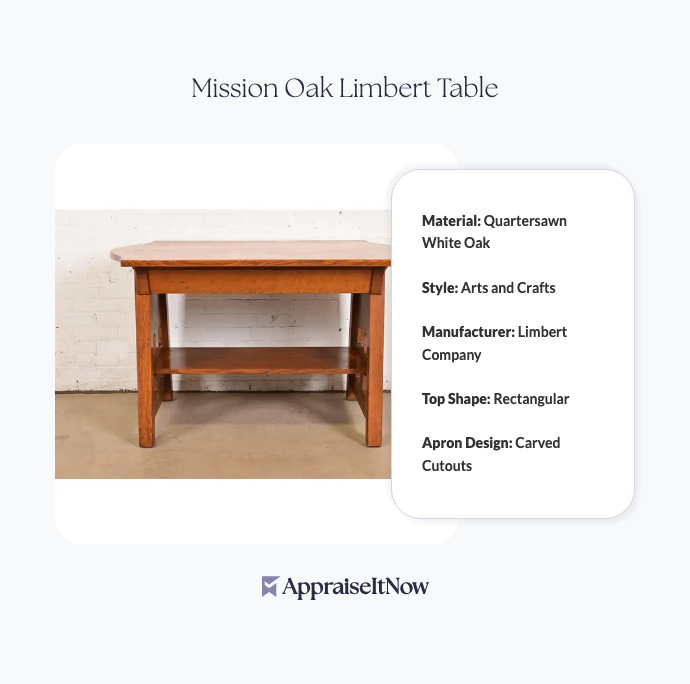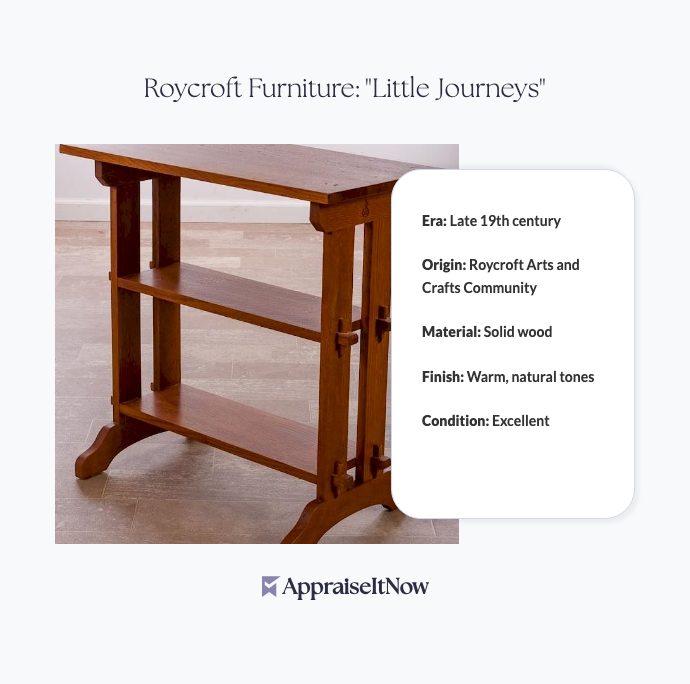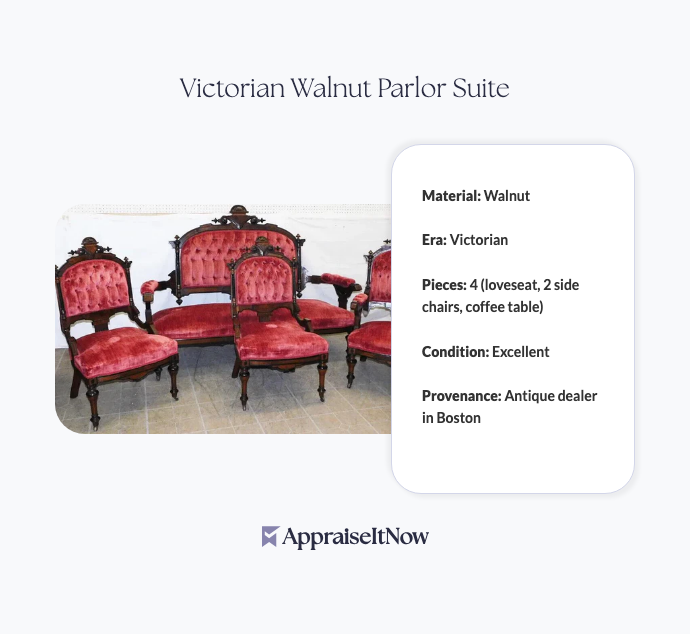<h1>How to Get Your Queen Anne Walnut Highboy Appraised</h1>
<p>A Queen Anne walnut highboy from the 18th century represents a significant piece of American furniture history and investment. If you own one—or are considering purchasing—understanding its market value between <strong>$18,000 and $25,000</strong> requires professional expertise. Whether you're selling, seeking insurance coverage, or documenting an estate, a certified appraisal provides the credibility and documentation you need.</p>
<h2>Understanding Queen Anne Walnut Highboy Value</h2>
<p>Your highboy's worth stems from multiple converging factors. The Queen Anne design, which emerged prominently in the 1720s, exemplifies refined craftsmanship that collectors and decorators value deeply today. The question <em>Is Queen Anne furniture worth anything?</em> has a clear answer: when executed in premium walnut with authentic period construction, these pieces command substantial market prices.</p>
<p>The specific features of your Queen Anne walnut highboy directly influence its appraisal value. Premium walnut construction provides warmth and patina that improves with age, while the distinctive serpentine-fronted chest of drawers creates visual interest that translates to collector demand. The carved cabriole legs with ball-and-claw feet represent hallmark Queen Anne characteristics, and when combined with delicate floral carvings and a central pediment, these details collectively drive valuation upward.</p>
<div class="callout tip"><p><strong>Value Driver</strong></p>
<p>Pieces featuring intact original finish and documented provenance typically command 15-25% premiums over refinished examples, even if restoration is expertly executed.</p></div>
<h2>Key Features That Impact Appraisal Results</h2>
<p>When an appraiser evaluates your highboy, they examine specific construction details that determine its place within the <strong>$18,000-$25,000</strong> range. The most sought-after antique furniture combines structural integrity, period-appropriate materials, and design authenticity—all elements present in genuine Queen Anne walnut highboys.</p>
<p>The serpentine front, a signature feature introduced during the Queen Anne period, requires skilled hand-planing that modern reproduction cannot easily replicate. Original walnut wood maintains color depth and consistency that synthetic finishes cannot match. The ball-and-claw feet, hand-carved from solid wood rather than applied, demonstrate the labor investment that justifies premium valuation. Floral and leaf motifs, carefully executed across the piece, further distinguish authentic examples from later interpretations.</p>
<p><em>Construction method matters significantly</em>. Hand-cut dovetails, mortise-and-tenon joinery, and period-appropriate hardware (often including original hardware or carefully matched replacements) all factor into professional appraisals. You can tell if a piece of furniture is valuable by examining whether joins show hand-tool marks characteristic of 18th-century production, and whether wood color and patina suggest authentic aging rather than artificial distressing.</p>
<table class='appraisal-table'>
<thead>
<tr>
<th>Feature</th>
<th>Impact on Value</th>
<th>Details</th>
</tr>
</thead>
<tbody>
<tr>
<td>Original finish</td>
<td>+20-25%</td>
<td>Untouched patina preferred by serious collectors</td>
</tr>
<tr>
<td>Walnut type</td>
<td>+10-15%</td>
<td>Premium walnut vs. secondary woods</td>
</tr>
<tr>
<td>Intact carving</td>
<td>+15-20%</td>
<td>All original design elements present</td>
</tr>
<tr>
<td>Documented provenance</td>
<td>+10-20%</td>
<td>Ownership history and exhibition records</td>
</tr>
<tr>
<td>Structural condition</td>
<td>Base value</td>
<td>Major repairs reduce premium potential</td>
</tr>
</tbody>
</table>
<h2>Condition Assessment and Honest Evaluation</h2>
<p>Before seeking professional appraisal, understand how condition affects your Queen Anne walnut highboy's value. The piece should retain its original height, width, and proportions—alterations reduce worth considerably. Original finish, even with wear and patina, typically values higher than refinishing, which can obscure details and reduce perceived authenticity.</p>
<p>Are your drawers functional? Do all original hardware elements remain, including pulls, handles, and escutcheons? Have the cabriole legs experienced breakage or repair? Is the serpentine front intact without cracks or major warping? Honest assessment of these factors helps set realistic expectations before appraisal. Professional appraisers examine wood type, joinery methods, and tool marks to verify age and authenticity—attempts to obscure condition through refinishing often backfire during expert evaluation.</p>
<div class="callout note"><p><strong>Honest Assessment</strong></p>
<p>Disclosing known repairs or alterations to your appraiser ensures accurate valuation and prevents complications during sale or insurance claim processes.</p></div>
<h2>Why Professional Appraisal Matters</h2>
<p>Determining the value of your old dresser or highboy yourself leads to undervaluation or dangerous overestimation. Professional appraisers bring specialized knowledge that you cannot replicate through online research. They understand Queen Anne design variations, recognize regional differences in construction methods, and access comparable sales data that informs realistic pricing.</p>
<p>When seeking an appraisal for insurance purposes, a certified professional provides documentation that insurers accept without question. Your appraiser photographs the piece from multiple angles, documents dimensions and construction details, and provides written analysis that supports the valuation. This becomes essential if you later need to file a claim—your appraisal report becomes the foundation for settlement discussions.</p>
<p>For estate planning or probate purposes, courts and legal professionals require independent professional appraisals rather than family estimates. Our blog articles on <a href="/blog/understanding-the-value-of-antique-furniture-examining-quality-and-rarity">understanding the value of antique furniture examining quality and rarity</a> and <a href="/blog/decoding-the-value-of-antique-furniture-materials-craftsmanship-and-historical-context">decoding the value of antique furniture materials craftsmanship and historical context</a> explore these factors in depth. Professional appraisers provide this credibility automatically through their credentials and USPAP compliance.</p>
<h2>Market Context: Queen Anne Furniture Popularity and Trends</h2>
<p><em>Is Queen Anne furniture still popular?</em> Absolutely. The enduring appeal of Queen Anne design stems from its graceful proportions and refined craftsmanship, which complement both traditional and transitional interiors. Contemporary interior designers frequently feature authentic Queen Anne pieces as focal points, driving steady collector demand and supporting valuations like your highboy's <strong>$18,000-$25,000</strong> range.</p>
<p>The era from which your Queen Anne furniture originates—primarily 1720-1760—represents a transitional period between heavier Jacobean styles and the rococo ornamentation that followed. This positioning gives Queen Anne pieces unique appeal: they exhibit sophisticated design without excessive ornamentation, making them adaptable to modern spaces while retaining undeniable historical significance. What wood is Queen Anne furniture made of? Premium walnut was the preferred choice for the finest examples, as you likely own, though mahogany and cherry also appear in period pieces.</p>
<p>Collectors actively seek Queen Anne highboys specifically because these tall chests of drawers serve practical purposes while displaying masterful craftsmanship. The form represents the peak of colonial American furniture making, combining English design sensibilities with resources available in the American colonies. Your walnut highboy embodies this heritage, explaining its strong market position among serious collectors and decorators.</p>
<h2>Documentation and Appraisal Preparation</h2>
<p>Preparing your Queen Anne walnut highboy for professional appraisal takes minimal effort but significantly enhances the process. Gather any documentation you possess: purchase receipts, auction house catalogs, previous appraisals, or family provenance information. Photographs from when you acquired the piece help document condition changes over time.</p>
<p>Before the appraiser arrives, ensure the piece is accessible and clean—but avoid any restoration attempts. Let professionals assess original finishes and construction methods unencumbered by recent work. Prepare a clear space for photography and documentation. When the appraiser requests detailed measurements or examination of underside construction, accommodate these requests fully; they're standard procedure for establishing authenticity and condition.</p>
<div class="callout tip"><p><strong>Documentation Tip</strong></p>
<p>Photographs showing any maker's marks, hardware details, or construction features provide valuable reference points during the appraisal process.</p></div>
<h2>Connecting with Qualified Appraisers</h2>
<p>AppraiseItNow connects you with credentialed appraisers specializing in antique furniture across the United States. Our network includes professionals certified by recognized organizations including AAA, ISA, ASA, CAGA, and AMEA—credentials that matter when your appraisal needs to withstand professional or legal scrutiny.</p>
<p>When selecting an appraiser, verify their specific experience with Queen Anne furniture and colonial American pieces. Ask about their methodology for establishing comparable sales data and their familiarity with regional variations in construction. A qualified appraiser will provide USPAP-compliant documentation and explain their valuation reasoning in clear, professional language. This expertise ensures your Queen Anne walnut highboy receives accurate assessment rather than generic antique furniture pricing.</p>
<p>When considering insurance or estate purposes, discuss those intentions with your appraiser—different situations sometimes require slightly different documentation approaches. For detailed guidance, our resource on <a href="/blog/what-expertise-is-necessary-when-appraising-antique-furniture">what expertise is necessary when appraising antique furniture</a> explains the specific qualifications you should verify before engaging professional services.</p>
<h2>Understanding Your Appraisal Report</h2>
<p>Your completed appraisal report should clearly identify the piece, photograph all significant details, and explain the valuation methodology. The appraiser documents dimensions, materials, construction methods, condition, and comparable sales that support the stated value. This detailed approach distinguishes professional appraisals from online estimates or casual valuations.</p>
<p>The report provides multiple value conclusions if relevant: insurance replacement value (what it would cost to replace with a similar piece today), fair market value (what a knowledgeable buyer and seller would agree upon), and liquidation value (what you might receive if selling quickly). Understanding these distinctions helps you use the appraisal appropriately whether for insurance, sale, or estate purposes.</p>
<h2>Next Steps After Appraisal</h2>
<p>With a completed professional appraisal in hand, you're positioned to move forward confidently. If selling, you have documentation supporting your asking price and can educate potential buyers about the piece's significance. If insuring, your appraisal provides the basis for appropriate coverage. If managing an estate, you've established documented value for distribution or tax purposes.</p>
<p>Regular reappraisal every 3-5 years ensures your insurance coverage remains adequate and documents market changes over time. The antique furniture market fluctuates with broader economic conditions and design trends, so periodic updates protect your investment and ensure accurate documentation.</p>
<div class="callout note"><p><strong>Key Takeaway</strong></p>
<p>A certified appraisal of your Queen Anne walnut highboy transforms uncertainty into confidence, providing documentation that serves you whether buying, selling, insuring, or preserving this significant piece of American furniture heritage. The <strong>$18,000-$25,000</strong> valuation range reflects genuine collector demand and historical significance—professional expertise ensures you understand and realize the full value of your investment.</p></div>







.avif)







